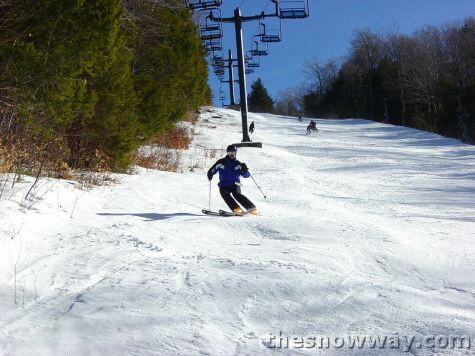
Few people would believe it, but only three major differences exist between an average skiers’ technique and that of an expert skier. Only three technical skills stand between limiting oneself to only skiing groomed trails and skiing any open trail on the mountain in any condition on any day. With a three year commitment and diligent practice, any skier with the desire and dedication can break through that invisible barrier separating the merely proficient skiers from those that define the grace and beauty inherent in a perfectly executed turn.
Let’s get one thing straight: you are not going to improve by simply reading an article or a book. A commitment must be made and followed through with training. Likely, the progression will take at least a three year time commitment and a lot of hard work. Crossing over is not a passive learning experience.
Muscle memory is an important aspect of training and I would recommend hitting the slopes at least three times a month at the least. The more time you spend on snow, the faster you will progress. Besides, what else could you possibly be doing on your weekends that is more important than skiing?
The first fundamental aspect of expert skiing technique is posture. Vertical alignment of the toes, knees, and nose place control of the skis solely in the skier’s possession. Most skiers lose control by getting into the dreaded “Back Seat,” so named because the skier looks like they are taking a dump. To attain a solid alignment while on skis, stand on a flat section of snow and jump up vertically. You will tend to land in a balanced position with your body aligned properly with a slight forward lean for balance. If you feel yourself sliding into the “Back Seat” while skiing, try throwing your hands forward while sliding your heel further back into the heel pocket of the boot. Essentially, throw your weight in a controlled motion over the tips of your skis. This action can be especially fear provoking on a steep pitch, so do not feel discouraged if you need to try this adjustment on less steep slope.
If vertical alignment is the first fundamental aspect of expert ski technique, it should come as no surprise that horizontal alignment is the second. Squaring the shoulders with the fall line is amongst the hardest techniques to continually perform correctly. Even seasoned experts will regularly find themselves suffering from loose shoulder syndrome. The shoulders should remain level; not dipping to either side, facing straight down the fall line. The tendency of most skiers is to drop the shoulder in the direction they are turning in and face into the turn. Resist this temptation by keeping the shoulders facing straight down the fall line throughout the turn. Focusing on an object and skiing directly towards “through your turns” will help as the line of sight should not change when you initiate turns. Also, try skiing a slope in which the sun is at your back. Doing a “Shadow Dance” with yourself is a great way to identify shoulders not squaring up to the fall line and other such alignment issues.
Our first two technical aspects did not involve any aspect of turning but rather focused on posture. You need to master your body posture before learning to effectively initiate a great turn. Once you have mastered your posture, you will be ready to properly analyze the turn.
Our final aspect of expert technique involves leg angulation while turning. Angulation will allow you to properly pressure the skis to carry through a turn without skidding or slipping, especially on what is affectionately referred in the East as New England Hard Pack or what is more widely inappropriately called “ice.” Additionally, proper angulation will help skiers navigate steeper slopes without sliding.
When an average skier turns, they usually do not exhibit much knee bend. If you were to draw a line between the hip and ankle on an average skier, the line would be mostly straight and unbent. Angulation involves bending the legs below the knees laterally which transfers energy, pressure, and control to the edge. The more radical the knee/leg bend, the more you will “pop” out of your turns. Ski racers are especially skilled at angulating their knees and are a good visual reference.
It is relatively easy to pick out an expert skier but much harder to emulate them. Watch their legs and how an angle is created between the ankle and hip with the knee being the fulcrum of the two radiuses. Focus on their alignment and how a proper posture combined with an angulated turn will transfer power and control most effectively between the snow, ski, and body.
Easier said than done right? Wrong. Before I made a commitment to drastically improve and become what I refer to as an All Mountain Skier, I was a struggling Upper Intermediate skier. I had mastered the skid turn, could parallel very well, and even prided myself on surviving a few steep groomed double diamond trails. But I could not ski bumps, trees, or powder and felt limited regarding where I could ski on the mountain and under which conditions I could do so. I learned these three fundamental techniques through ski race training and they fundamentally altered how I ski and how much I enjoy doing so. In three short years, I became an All Mountain Skier that could ski any trail at any time in any condition. I went into the trees and soon after began looking off piste in the Back Country for fun and adventure because I was no longer challenged at ski areas.
Not sure if you are up for the challenge and commitment? Well know this before you condemn yourself to the ranks of the struggling Upper Intermediate for life: The better you get, the more you enjoy each and every turn. I know this for a fact.